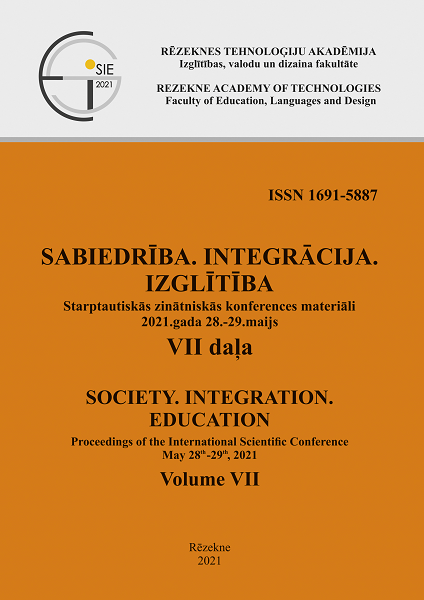STRESSORS OF THE STUDY PROCESS, THEIR EMPIRICAL RESEARCH AT RĒZEKNE ACADEMY OF TECHNOLOGIES
DOI:
https://doi.org/10.17770/sie2021vol7.6369Keywords:
students, stress level, stressors directly related to study process, stressors indirectly related to study process, academic achievements, psychological well-beingAbstract
This scientific article presents a theoretical review of stress factors of young students and the results of empirical research of these factors at the Rezekne Academy of Technologies. The need for such research is justified by International studies (n=540 000), in which was found that the study process causes high level of stress in 37% of students. The results of other studies in different countries also show that the prevalence and severity of mental problems among students is increasing. Overall, these studies indicate that students are increasingly experiencing symptoms of increased anxiety and stress, as well as depression. Thus, increase in student stress levels and related deterioration of students' psychological well-being is a major challenge in today's higher education institutions.
Taking into account the mentioned findings, the aim of this article is to identify the most common stress factors in the study process at the Rezekne Academy of Technologies.
The analysis of scientific literature and empirical results were used as basic methods in the development of the article.
Downloads
References
Baik, C., Naylor, R., & Arkoudis, S. (2015). The first year experience in Australian universities: Findings from two decades, 1994-2014. Melbourne, Australia: Melbourne Centre for the Study of Education. Retrieved from https://melbourne-cshe.unimelb.edu.au/__data/assets/pdf_file/0016/1513123/FYE-2014-FULL-report-FINAL-web.pdf
Bexley, E., Daroesman, S., Arkoudis, S., & James, R. (2013). University Student Finances
in 2012: A Study of the Financial Circumstances of Domestic and International Students in Australia’s Universities. Canberra: Universities Australia. DOI: 10.3928/01484834-20170619-04
Boulton, M., & O’Connell, K. A. (2017). Nursing students’ perceived faculty support, stress, and substance misuse. The Journal of Nursing Education, 56 (7), 404–411.
Cvetkovski, S., Reavley, N. J., & Jorm, A. F. (2012). The prevalence and correlates of psychological distress in Australian tertiary students compared to their community peers. Australian and New Zealand Journal of Psychiatry, 46(5), 457-467. DOI: 10.1177/0004867411435290
Denovan, A., & Macaskill, A. (2017). Stress and subjective well-being among first year UK undergraduate students. Journal of Happiness Studies, 18(2), 505–525. DOI: 10.1007/s10902-016-9736-y
Eisenberg, D., Golberstein, E., & Hunt, J.B. (2009). Mental Health and Academic Success in College. The B.E. Journal of Economic Analysis & Policy, 9 (1), Article 40. DOI: 10.2202/1935-1682.2191
Eisenberg, D., Gollust, S. E., Golberstein, E., & Hefner, J. L. (2007). Prevalence and correlates of depression, anxiety, and suicidality among university students. The American Journal of Orthopsychiatry, 77(4), 534–542. DOI: 10.1037/0002-9432.77.4.534
Fawaz, M., & Samaha, A. (2020). E‐learning: Depression, anxiety, and stress symptomatology among Lebanese university students during COVID‐19 quarantine. Nursing forum. DOI: 10.1111/nuf.12521
Frymier, B., & Houser, M. (2000). The teacher-student relationship as an interpersonal relationship. Communication Education, 49(3), 207–19. DOI: 10.1080/03634520009379209
Haider, I. (2017). Effect of stress on academic performance of undergraduate medical students. Community of Medical Health Education, 7, 566 – 615.
Larcombe, W, Finch, S, & Sore, R. (2016). Prevalence and socio-demographic correlates of psychological distress among students at an Australian university. Studies in Higher Education, 41(6), 1074–91. DOI: 10.1080/03075079.2014.966072
Lee, S. Y., Wuertz, C., Rogers, R., & Chen, Y. P. (2013). Stress and sleep disturbances in female college students. American Journal of Health Behavior, 37(6), 851–858.
Lin, S, & Huang, H (2014) Life stress and academic burnout. Active Learning in Higher Education, 15(1), 77–90. DOI: 10.1177/1469787413514651
Liu, Y. Y. (2015). The longitudinal relationship between Chinese high school students’ academic stress and academic motivation. Learning and Individual Differences, 38,123–126. DOI: 10.1016/j.lindif.2015.02.002
McKean, M, R. (2000). College students’ academic stress and its relation to their anxiety time, management, and leisure, satisfaction. American Journal of Health Studies, 16, 41-51.
Nepomuceno, B.B, Cardoso, A.A., Ximenes, V.M., Barros, J.P., & Leite, J.F. (2016). Mental health, well-being, and poverty: A study in urban and rural communities in Northeastern Brazil. Journal of Prevention & Interview in the Community, 44(1), 63-75. DOI: 10.1080/10852352.2016.1102590
Ozen, N. S., Ercan, I., Irgil, E., & Sigirli, D. (2010). Anxiety prevalence and affecting factors among university students. Asia-Pacific Journal of Public Health / Asia-Pacific Academic Consortium for Public Health, 22 (1), 127–133. DOI: 10.1177/1010539509352803
Ryan, C. (2014). Youth Allowance and the Financial Position of Young Australians. Australian Economic Review 47(1), 115–123. DOI: 10.1111/1467-8462.12056
Slavin, S. J., Schindler, D. L., & Chibnall, J. T. (2014). Medical student mental health 3.0:
improving student wellness through curricular changes. Academic Medicine, 89(4), 573-577. DOI: 10.1097/ACM.0000000000000166
The Organisation for Economic Co-operation and Development. (2017). Students’ Well-Being: PISA 2017 Results. https://www.oecd-ilibrary.org/docserver/9789264273856-en.pdf?expires=1615475992&id=id&accname=guest&checksum=536328FC1AABBE490234C8B773D5A99A
Walburg, V. (2014). Burnout among high school students: A literature review. Children and Youth Services Review, 42, 28–33. DOI: 10.1016/j.childyouth.2014.03.020
Walsh, J. M., Feeney, C., & Hussey, J. (2010). Sources of stress and psychological morbidity among undergraduate physiotherapy students. Physiotherapy, 96(3), 206–12. DOI: 10.1016/j.physio.2010.01.005


